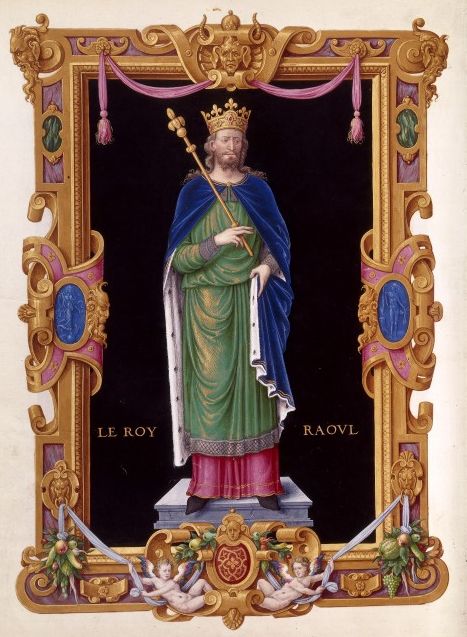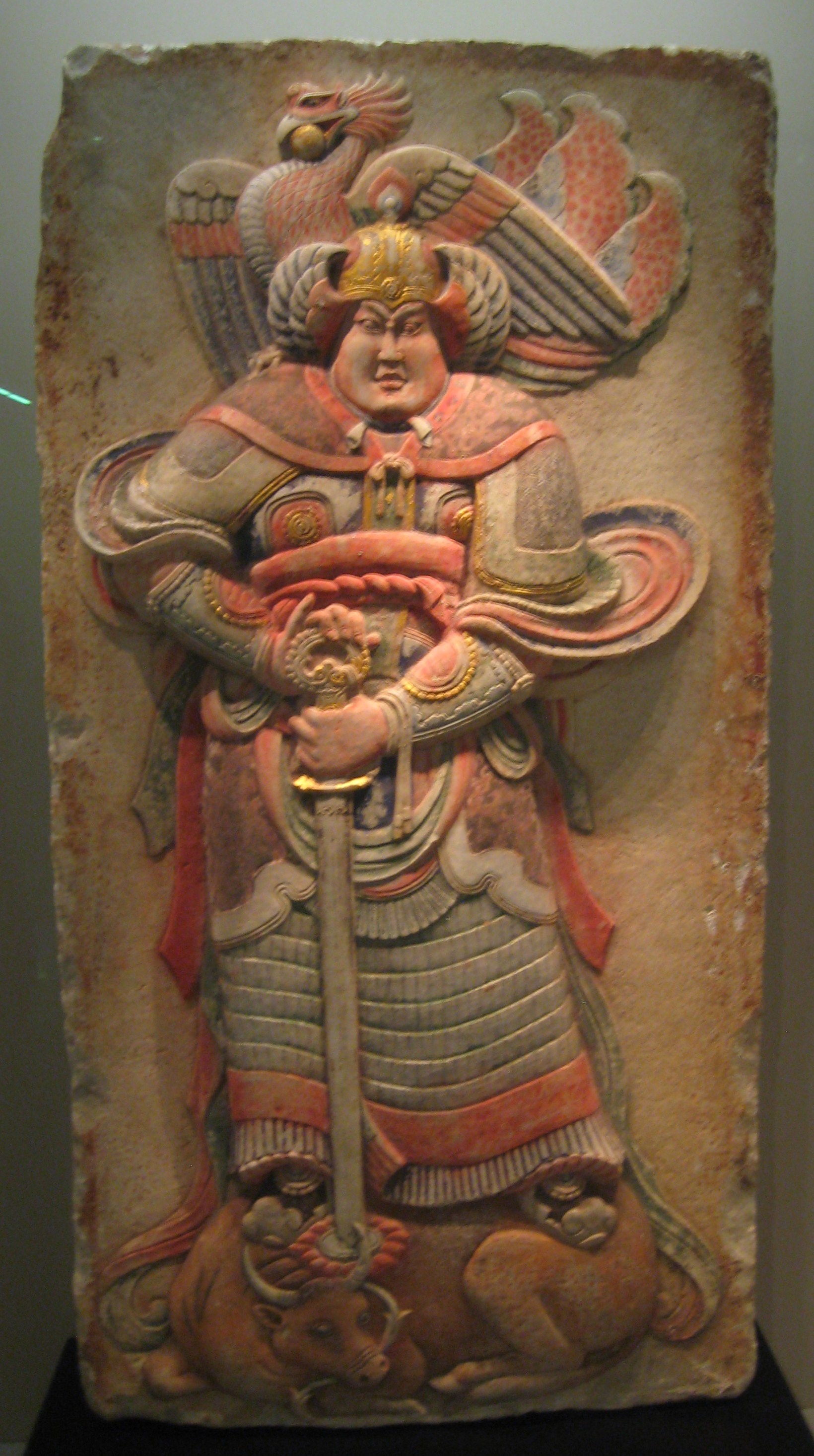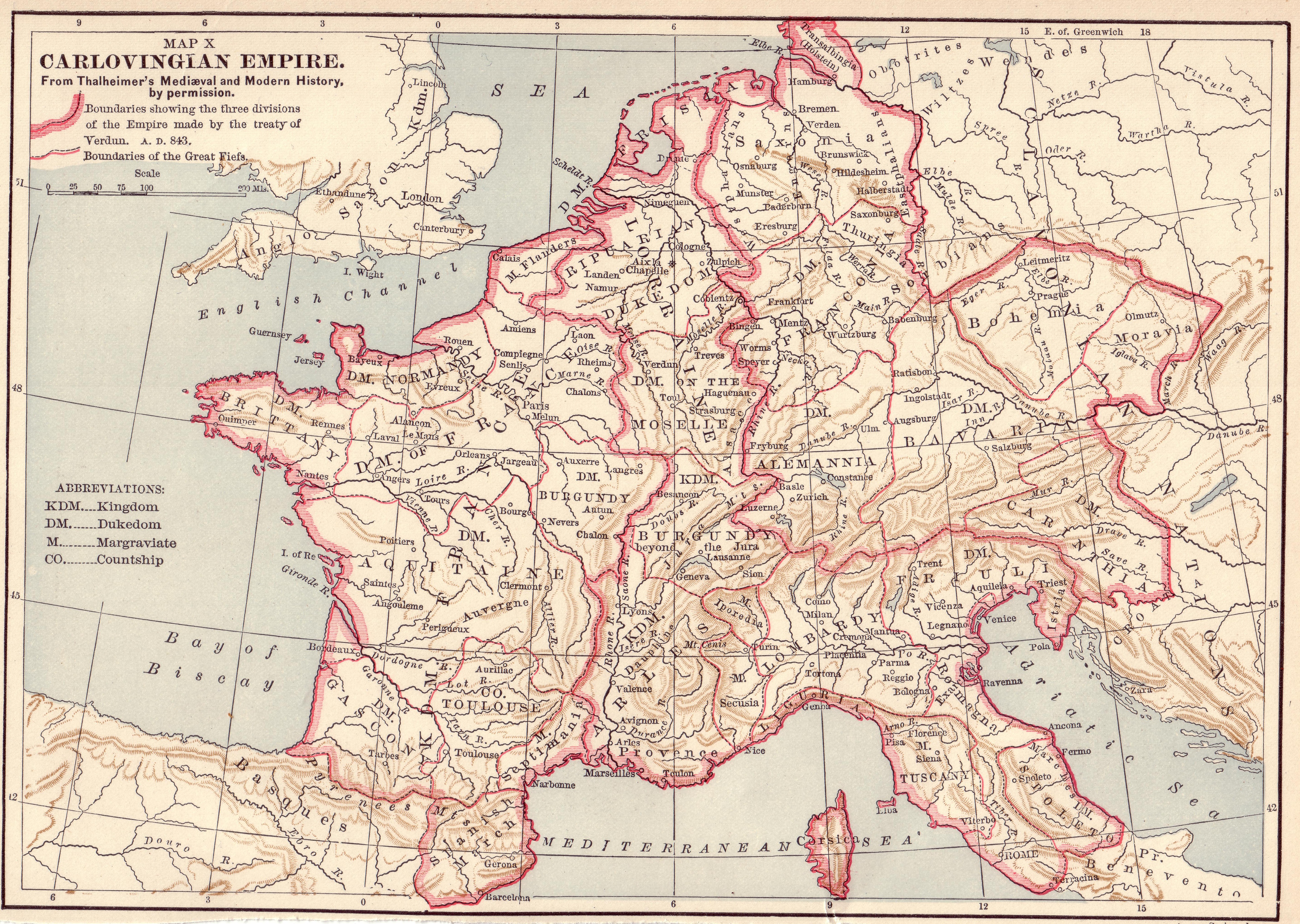|
923
__NOTOC__ Year 923 ( CMXXIII) was a common year starting on Wednesday (link will display the full calendar) of the Julian calendar. Events By place Europe * June 15 – Battle of Soissons: King Robert I is killed; the Frankish army, led by Charles the Simple, is defeated and routed near Soissons. Charles is captured and imprisoned at Péronne. The nobles elect Robert's son-in-law Rudolph, duke of Burgundy, as king of the West Frankish Kingdom (until 936). * July 29 – Battle of Fiorenzuola: Lombard forces led by King Rudolph II and Adalbert I, margrave of Ivrea, defeat the deposed Emperor Berengar I at Firenzuola (Tuscany). A pact is reached between Rudolph and Berengar, who abdicates the imperial throne and cedes sovereignty over the rest of Italy. Asia * May 13 – The Later Liang, one of the Five Dynasties in China, falls to Later Tang (founded by Li Cunxu). Li proclaims himself emperor and moves his residence back to the old Tang capital ... [...More Info...] [...Related Items...] OR: [Wikipedia] [Google] [Baidu] |
Li Cunxu
Emperor Zhuangzong of Later Tang (), personal name Li Cunxu (), nickname Yazi (), stage name Li Tianxia (), was the ruling prince of the Former Jin dynasty (r. 908–923) and later became the founding emperor of the Later Tang dynasty (r. 923–926) during the Five Dynasties and Ten Kingdoms period of Chinese history.Cihai: Page 1266. He was the son of Li Keyong, an ethnic Shatuo Jiedushi of the Tang dynasty. Li Cunxu was considered one of the most militarily capable rulers of the Five Dynasties and Ten Kingdoms Period. When he succeeded his father Li Keyong as the Prince of Jin, Jin had been weakened in the late years of Li Keyong's rule and not considered capable of posing a military threat to its archrival to the south, Later Liang, whose founding emperor Zhu Quanzhong had seized the Tang throne. Li Cunxu carefully rebuilt the Jin state, using a series of conquests and alliances to take over most of the territory north of the Yellow River, before starting a lengthy campai ... [...More Info...] [...Related Items...] OR: [Wikipedia] [Google] [Baidu] |
Later Tang
Tang, known in historiography as the Later Tang, was a short-lived imperial dynasty of China and the second of the Five Dynasties during the Five Dynasties and Ten Kingdoms period in Chinese history. The first three of the Later Tang's four emperors were ethnically Shatuo. The name Tang was used to legitimize itself as the restorer of the Tang dynasty. Although the Later Tang officially began in 923, the dynasty already existed in the years before, as a polity known in historiography as the Former Jin (907–923). At its height, Later Tang controlled most of northern China. Formation From the fall of the Tang Dynasty in 907, a rivalry had developed between the successor Later Liang, formed by Zhu Wen, and the State of Jin, formed by Li Keyong, in present-day Shanxi. The rivalry survived the death of Li Keyong, whose son Li Cunxu continued to expand Jin territories at the expense of the Later Liang. Li Keyong forged an alliance with the powerful Khitan, like the Shatuo a ... [...More Info...] [...Related Items...] OR: [Wikipedia] [Google] [Baidu] |
Later Liang (Five Dynasties)
Liang, known in historiography as the Later Liang () (1 June 907 – 19 November 923) or the Zhu Liang (), was an imperial dynasty of China and the first of the Five Dynasties during the Five Dynasties and Ten Kingdoms period. It was founded by Zhu Wen (Emperor Taizu), after he forced the last emperor of the Tang dynasty to abdicate in his favour (and then murdered him). The Later Liang would last until 923 when it was destroyed by the Later Tang dynasty. Formation Zhu Wen initially allied himself as Huang Chao's lieutenant. However, he took Huang's best troops and established his own power base as a warlord in Kaifeng. By 904, he had exerted control over both of the twin Tang Dynasty capitals of Chang'an and Luoyang. Tang emperor Zhaozong was ordered murdered by Zhu in 904 and the last Tang emperor, Ai Di ( Emperor Ai of Tang), was deposed three years later. Emperor Ai of Tang was murdered in 908, also ordered by Zhu. Meanwhile, Zhu Wen declared himself emperor of t ... [...More Info...] [...Related Items...] OR: [Wikipedia] [Google] [Baidu] |
July 29
Events Pre-1600 *587 BC – The Neo-Babylonian Empire sacks Jerusalem and destroys the First Temple. * 615 – Pakal ascends the throne of Palenque at the age of 12. * 904 – Sack of Thessalonica: Saracen raiders under Leo of Tripoli sack Thessaloniki, the Byzantine Empire's second-largest city, after a short siege, and plunder it for a week. * 923 – Battle of Firenzuola: Lombard forces under King Rudolph II and Adalbert I, margrave of Ivrea, defeat the dethroned Emperor Berengar I of Italy at Firenzuola (Tuscany). * 1014 – Byzantine–Bulgarian wars: Battle of Kleidion: Byzantine emperor Basil II inflicts a decisive defeat on the Bulgarian army, and his subsequent treatment of 15,000 prisoners reportedly causes Tsar Samuil of Bulgaria to die of a heart attack less than three months later, on October 6. *1018 – Count Dirk III defeats an army sent by Emperor Henry II in the Battle of Vlaardingen. * 1030 – Ladejarl- Fairhair success ... [...More Info...] [...Related Items...] OR: [Wikipedia] [Google] [Baidu] |
Rudolph Of France
Rudolph (french: Rodolphe), sometimes called Ralph (; c. 890 – 14/15 January 936), was the king of France from 923 until his death in 936. He was elected to succeed his father-in-law, Robert I, and spent much of his reign defending his realm from Viking raids. Name In contemporary Latin documents, his name is usually ''Rodulfus'', from the Germanic roots ''hruod'', "fame, glory", and ''wulf'', "wolf". Rodulf and Rudolf are variants of this name; the French form is ''Rodolphe''. By contrast, the king is normally known as ''Raoul'' in modern French, a name which derives from ''Radulfus'', from Germanic ''rad'', "counsel", and ''wulf'' (whence Ralph). Although this name is of different origin, it was sometimes used interchangeably by contemporaries with ''Rodulfus''. The king himself, however, always used ''Rodulfus'', as on his personal seal. Nonetheless, he is sometimes called Ralph (from ''Raoul'') or Radulf in English. Background Rudolph was born around 890, the son of Ric ... [...More Info...] [...Related Items...] OR: [Wikipedia] [Google] [Baidu] |
June 15
Events Pre-1600 * 763 BC – Assyrians record a solar eclipse that is later used to fix the chronology of Mesopotamian history. * 844 – Louis II is crowned as king of Italy at Rome by pope Sergius II. * 923 – Battle of Soissons: King Robert I of France is killed and King Charles the Simple is arrested by the supporters of Duke Rudolph of Burgundy. *1184 – The naval Battle of Fimreite is won by the Birkebeiner pretender Sverre Sigurdsson. Sigurdsson takes the Norwegian throne and King Magnus V of Norway is killed. *1215 – King John of England puts his seal to Magna Carta. *1219 – Northern Crusades: Danish victory at the Battle of Lindanise (modern-day Tallinn) establishes the Danish Duchy of Estonia. *1246 – With the death of Frederick II, Duke of Austria, the Babenberg dynasty ends in Austria. *1300 – The city of Bilbao is founded. *1312 – At the Battle of Rozgony, King Charles I of Hungary wins a decisive victor ... [...More Info...] [...Related Items...] OR: [Wikipedia] [Google] [Baidu] |
Charles The Simple
Charles III (17 September 879 – 7 October 929), called the Simple or the Straightforward (from the Latin ''Carolus Simplex''), was the king of West Francia from 898 until 922 and the king of Lotharingia from 911 until 919–923. He was a member of the Carolingian dynasty. Early life Charles was the third and posthumous son of king Louis the Stammerer by his second wife Adelaide of Paris.Detlev Schwennicke, ''Europäische Stammtafeln: Stammtafeln zur Geschichte der Europäischen Staaten'', Neue Folge, Band II (Marburg, Germany: J. A. Stargardt, 1984), Tafel 1 As a child, Charles was prevented from succeeding to the throne at the time of the death in 884 of his half-brother, king Carloman II. Instead, Frankish nobles of the realm asked his cousin, Emperor Charles the Fat, to assume the crown. He was also prevented from succeeding the unpopular Charles the Fat, who was deposed in November 887 and died in January 888, although it is unknown if his overthrow was accepted o ... [...More Info...] [...Related Items...] OR: [Wikipedia] [Google] [Baidu] |
China
China, officially the People's Republic of China (PRC), is a country in East Asia. It is the world's List of countries and dependencies by population, most populous country, with a Population of China, population exceeding 1.4 billion, slightly ahead of India. China spans the equivalent of five time zones and Borders of China, borders fourteen countries by land, the List of countries and territories by land borders, most of any country in the world, tied with Russia. Covering an area of approximately , it is the world's third List of countries and dependencies by area, largest country by total land area. The country consists of 22 provinces of China, provinces, five autonomous regions of China, autonomous regions, four direct-administered municipalities of China, municipalities, and two special administrative regions of China, Special Administrative Regions (Hong Kong and Macau). The national capital is Beijing, and the List of cities in China by population, most populous cit ... [...More Info...] [...Related Items...] OR: [Wikipedia] [Google] [Baidu] |
West Francia
In medieval history, West Francia (Medieval Latin: ) or the Kingdom of the West Franks () refers to the western part of the Frankish Empire established by Charlemagne. It represents the earliest stage of the Kingdom of France, lasting from about 840 until 987. West Francia emerged from the partition of the Carolingian Empire in 843 under the Treaty of Verdun following the death of Charlemagne's son, Louis the Pious. It is considered the first polity in French history. West Francia extended further north and south than modern metropolitan France, but it did not extend as far east. It did not include such future French holdings as Lorraine, the County and Kingdom of Burgundy (the duchy was already a part of West Francia), Alsace and Provence in the east and southeast for example. It also did not include the Brittany peninsula in the west. In addition, by the 10th century the authority of the West Frankish monarchs was greatly reduced. This was contrasted by the evergrowing power o ... [...More Info...] [...Related Items...] OR: [Wikipedia] [Google] [Baidu] |
Battle Of Soissons (923)
The Battle of Soissons was fought on 15 June 923 between an alliance of Frankish insurgent nobles led by Robert I, elected king in an assembly the year prior, and an army composed of Lotharingians, Normans, and Carolingian forces under King Charles III's command. The battle took place at Soissons, near Aisne. Robert was killed, but his army won the war. Charles was imprisoned by Herbert II of Vermandois and held captive until his death in 929. Rudolph, Duke of Burgundy, Robert's son-in-law, succeeded him as ruler of West Francia. Background After Charlemagne's death, the Carolingian royal authority began to decline due to the constant invasions of the Vikings, civil wars and strife with vassals, mainly the Robertians. Since its beginning, the political situation of Charles's reign was fragile. Frankish nobility was unwilling to accept his authority. One of his few allies was Baldwin II of Flanders. Charles' attempts to restore Carolingian power over Lotharingia, the homeland ... [...More Info...] [...Related Items...] OR: [Wikipedia] [Google] [Baidu] |
Five Dynasties
The Five Dynasties and Ten Kingdoms period (), from 907 to 979, was an era of political upheaval and division in 10th-century Imperial China. Five dynastic states quickly succeeded one another in the Central Plain, and more than a dozen concurrent dynastic states were established elsewhere, mainly in South China. It was a prolonged period of multiple political divisions in Chinese imperial history. Traditionally, the era is seen as beginning with the fall of the Tang dynasty in 907 and reaching its climax with the founding of the Song dynasty in 960. In the following 19 years, Song gradually subdued the remaining states in South China, but the Liao dynasty still remained in China's north (eventually succeeded by the Jin dynasty), and the Western Xia was eventually established in China's northwest. Many states had been ''de facto'' independent long before 907 as the Tang dynasty's control over its officials waned, but the key event was their recognition as sovereign by forei ... [...More Info...] [...Related Items...] OR: [Wikipedia] [Google] [Baidu] |
Battle Of Fiorenzuola
The Battle of Firenzuola was fought on 29 July 923 between the forces of Rudolph II of Burgundy and Adalbert I of Ivrea on one side and Berengar I of Italy on the other. The battle was a defeat for Berengar, who was thus ''de facto'' dethroned and replaced by Rudolf as King of Italy. His own grandson and namesake, Berengar II, who would later be king of Italy as well, fought on the winning side against him. Background Berengar was supported principally by the German faction in Italy. He was defeated by Guido of Spoleto in 889. He re-emerged as sole king in Italy in 898 after the death of Lambert of Spoleto. Louis of Provence was elected as king of Italy in 900, with support particularly from Anscar I of Ivrea. Berengario defeated Louis twice, the second time conclusively in 905 when he had his rival blinded. He was crowned Emperor at Rome in 916. Prelude He allied himself with the Magyars to defeat King Rudolph II of Burgundy, who emerged as another rival candidate for the Ita ... [...More Info...] [...Related Items...] OR: [Wikipedia] [Google] [Baidu] |





